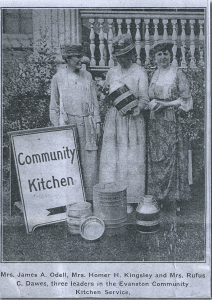
Evanston women and women’s organizations have faced community and national crises with imagination and ingenuity in times past as they are today. One interesting example is the Evanston Community Kitchen which was started as a project of three members of the Woman’s Club of Evanston.
In the summer of 1918, the Woman’s Club of Evanston’s Community Kitchen Committee (CKC), composed of Helen Palmer Dawes, Mrs. James Odell and Nellie Fitch Kingsley, organized the preserving and canning of 7,000 jars of fruits and vegetables in the club’s basement kitchen. This food was distributed to various charitable institutions and some was sold for profit to those who could afford it. The CKC had its roots in the food conservation movement of World War I and the need for food rationing, which placed a high priority on improving efficiency and efficacy in food production.
In October 1918, when the influenza epidemic reached northern Illinois, the kitchen was reorganized as an “emergency kitchen.” For two weeks the kitchen prepared an average of 200 meals per day for families unable to provide for themselves due to the flu crisis.
Struck by the success of these two operations, the women sought out other productive uses for the kitchen. The idea of a community kitchen was in currency at the time and community kitchens were in place in parts of Europe and the east coast. In 1919, the women traveled to the east coast to visit cooked food service kitchens there. Encouraged by what they observed on their fact-finding trip and buoyed by the enthusiasm of their peers, the CKC began to organize the Evanston Community Kitchen.
For the full story, visit the EWHP Research Database entry for the kitchen here.
